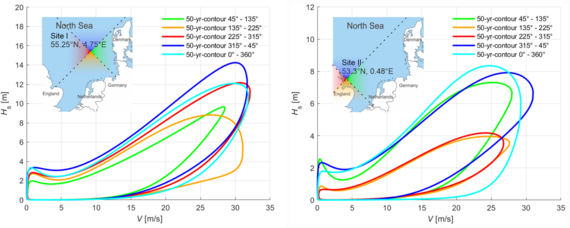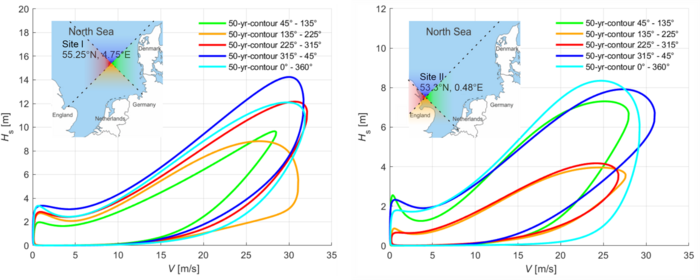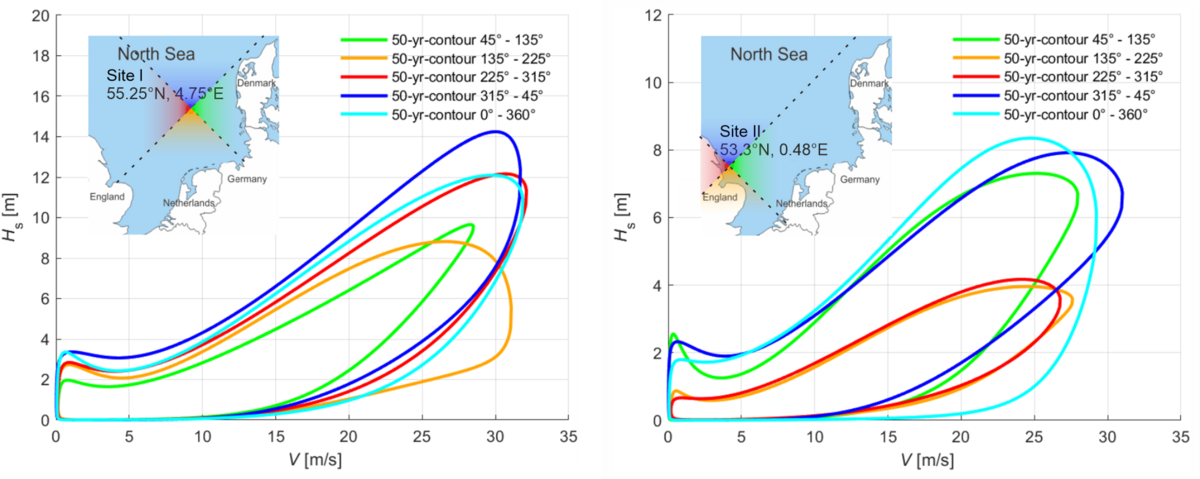In the case of offshore wind turbines (OWTs), environmental conditions dominate the loads in addition to deadweight loads and loads from operation. In particular, wind, wave and current loads and, if applicable, temperature are relevant for the design of offshore support structures. At the same time, OWTs are characterised by high dynamic loads, variable load scenarios and actively controlled systems (e.g., pitch control of the rotor blades or (semi-)active damping systems). In addition to a detailed description of the megastructure-specific environmental conditions and their scatter (SP A1 (Link) and A3 (Link)), the realistic combination of the above-mentioned loads significantly influences the reliability and economic efficiency of offshore megastructures.
In contrast to structural engineering, where effects of loads (e.g. internal forces) are usually combined, environmental conditions are mostly combined for OWTs. All relevant combinations of environmental conditions (and operating conditions) are then applied in aero-hydro-servo-elastic simulations of the OWT to determine the effects, taking into account the dynamic behaviour of the entire structure and the actively controlled systems of the OWT. To ensure a safe design of the offshore support structures, combinations that are not characterised by individual extreme events must also be taken into account. For example, cyclic wind or wave loads below individual extreme events can also lead to design-relevant stresses due to the dynamic structural response.
For the simultaneous occurrence of extreme meteorological and oceanographic ("metocean") environmental conditions, probabilistic combination approaches exist, which were developed for the combination of wind conditions in the Prandtl layer and the sea state. The direction of action of the load parameters is neglected here and the structural design is usually carried out for the structurally most unfavourable directional superposition of the load parameters – which is not based on physical principles. The working hypothesis of SP A05 is that for future material-optimised offshore megastructures, combination approaches will be required that, in addition, realistically take into account the direction of the load parameters and the combination of oceanographic environmental conditions with wind conditions in the Prandtl and Ekman layers. In future offshore megastructures with hub heights of > 170 m and rotor diameters of > 280 m, large parts of the rotor area will be located in the Ekman layer. This lies above the Prandtl layer (lower part of the atmospheric boundary layer, which extends to a height of about 150 m) and is characterised by a largely laminar flow and only a slight increase in wind speed with increasing height. It no longer interacts directly with the wind-excited waves. The wind direction in this layer is clearly more influenced by the geostrophic wind direction and may therefore differ more from the wind direction in the Prandtl layer – and probably also the wave direction. Also largely unexplored is the combination of swell waves and local wind and sea state conditions with regard to probability of occurrence, intensity and effects on structural loading. Swell waves are waves generated by distant storm areas or winds and can differ significantly in height, period and direction from wind-excited waves.
In addition, conventional combination approaches and joint probability models have so far focused on the environmental conditions for the design of support structures. The transport, installation and dismantling of very large and heavy components of offshore megastructures also require methods that allow a realistic description and reliable prediction of combined metocean conditions. Compared to conventional joint probability models, the duration of the simultaneous metocean conditions that enable transport or installation must be taken into account probabilistically.
The overall objective of SP A5 is therefore the research and development of data-based combination methods for the realistic description and prediction of simultaneously occurring environmental conditions, taking into account the direction of action of the load parameters. In the second funding period, these combination methods will be validated in demonstrator experiments in the Large Wave Current Flume (GWK+) using selected random variables of the wave and current conditions, investigated with regard to their effects on the structural loading by aero-hydro-servo-elastic simulations using the digital twin and extended to probabilistic prediction models of transport and assembly time windows.
SP A5 works closely with SP A1 (Link) and SP A7 (Link) in the cluster Wind and wave interactions and provides them with combined environmental conditions for stochastic wind field and sea state modelling. As the central interface between the environmental conditions and the support structure, SP A5 provides combined load parameters as input values for the aero-hydro-servo-elastic simulations in SP Z1 (Link) or additionally carries out its own aero-hydro-servo-elastic simulations using the digital twin from SP Z1.



[1] Kaliske, M.; Schmidt, B. Analysing the Directional Dependence of Wind and Wave Interactions for Offshore Wind Turbines Using Environmental Contours. J. Mar. Sci. Eng. 2024, 12, 1116
Publications
-
2024: Analysing the directional dependence of wind and wave interactions for offshore wind turbines using environmental contours
Kaliske, M., Schmidt, B. (2024): Analysing the directional dependence of wind and wave interactions for offshore wind turbines using environmental contours, Journal of Marine Science and Engineering
https://doi.org/10.3390/jmse12071116
-
2023: Innovative combination approach for environmental parameters of offshore wind turbines
Kaliske, M., Schmidt, B., Oettel, V. (2023): Innovative combination approach for environmental parameters of offshore wind turbines, Proceedings 19th EAWE PhD seminar on Wind Energy
-
2022: Entwurf von Offshore-Windenergieanlagen neuer Größenordnung als Grundpfeiler unserer zukünftigen Energieversorgung
Hübler, C.; Schmidt, B.; Voß, S.; Hente, C.; Gebhardt; C.G.; Ribnitzky, D.; Rolfes, R. (2022): Entwurf von Offshore-Windenergieanlagen neuer Größenordnung als Grundpfeiler unserer zukünftigen Energieversorgung, Proceedings "Dresdner Baustatik Seminar"
-
2021: Comparison of environmental contour methods
Rode, A., Schmidt, B. (2021): Comparison of environmental contour methods, Proceedings 17th EAWE PhD Seminar on Wind Energy
-
2021: Sensitivity analysis of the environmental contour methods to derive extreme met-ocean conditions
Rode, A., Schmidt, B., Hildebrandt, A. (2021): Sensitivity analysis of the environmental contour methods to derive extreme met-ocean conditions, WESC Conference
-
2021: A benchmarking exercise for environmental contours
Haselsteiner, A.F.; Coe, R.G.; Manuel, L.; Chai, W.; Leira, B.; Clarindo, G.; Guedes Soares, C.; Hannesdóttir, Á.; Dimitrov, N.; Sander, A.; Ohlendorf, J.-H.; Thoben, K.-D.; de Houteclocque, G.; Mackey, E.; Jonathan, P.; Qiao, C.; Myers, A.; Rode, A.; Hildebrandt, A.; Schmidt, B.; Vanem, E.; Huseby, A.B. (2021): A benchmarking exercise for environmental contours, Ocean Engineering, 236, 109504
Subproject Management
Institut für Baustoffe, Massivbau und Brandschutz (iBMB)
Fachgebiet Massivbau
Beethovenstraße 52
38106 Braunschweig
Institut für Baustoffe, Massivbau und Brandschutz (iBMB)
Fachgebiet Massivbau
Beethovenstraße 52
38106 Braunschweig
